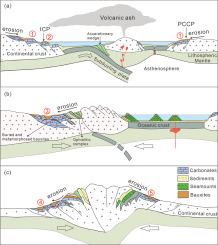Earth-Science Reviews ( IF 12.1 ) Pub Date : 2022-09-12 , DOI: 10.1016/j.earscirev.2022.104184 Shujuan Yang , Qingfei Wang , Xuefei Liu , Ziyan Kan , M. Santosh , Jun Deng

|
Karst bauxites over the world have significant economic value and the geodynamic controls of their formation have attracted wide attention. These deposits are distributed over a vast region in the Tethyan realm, formed in diverse geological times and tectonic settings under a relatively monotonous warm and humid paleoclimate. This study reviews the spatio-temporal distribution of karst bauxites and their geodynamic and paleoclimatic settings based on paleogeographic reconstruction of the Tethyan realm. We show that karst bauxites were mainly formed in three orogenic domains: (1) the Ural-Central Asia belt, which formed at low paleolatitudes during the Cambrian through Devonian controlled by the Proto-Tethys and the Paleo-Asian Ocean, and later during Carboniferous and Cretaceous-Paleogene at mid-high paleolatitudes influenced by the heat transport from Paleo-Tethys and Neo-Tethys via seaways, (2) the Carboniferous to Permian Eastern Asia belt and westerly younger late Permian to Jurassic Turkey-Iran-Afghanistan-Pakistan belt formed in low paleolatitudes within the region of Paleo-Tethys, and (3) the Late Cretaceous-Paleogene Mediterranean belt and Neogene Caribbean belt controlled by the evolution of Neo-Tethys. The spatial shift of bauxitization with time was controlled by the paleogeographic evolution of Tethys and the resulting changes of oceanic current circulation and paleoclimate. We identify common scenarios of diverse metallogenic models in specific geodynamic phases through a combined analysis of chronological data on detrital zircons and local sedimentological sequences. In the continental extension phase, basement rocks were exposed to provide dominant materials for the formation of bauxite deposits on eroded carbonate platforms along continental margins. In the oceanic subduction phase, the arc volcanism provided abundant volcaniclastic materials, especially for the bauxite deposits on isolated carbonate platforms. In the arc accretion phase, weathered remnants were transported from complex nappes into intracontinental carbonate depressions. The karst bauxite deposits originally formed in a specific tectonic stage were superimposed by later tectonic reworking, and were metamorphosed, or exposed, disrupted, eroded, redeposited and altered during later continental collision stage, whereas incipient bauxite accumulation restarted during post-collisional extension phase. These processes occurring within the similar favorable paleoclimatic background define a unified metallogenic system concomitant with Wilson cycle that explains the spatio-temporal distribution of karst bauxites in the Tethyan realm.
中文翻译:

岩溶铝土矿的全球时空变化和成矿多样性及其与特提斯域演化的构造、古地理和古气候关系
全球岩溶铝土矿具有重要的经济价值,其形成的地球动力学控制已引起广泛关注。这些矿床分布在特提斯地区的广大地区,形成于不同的地质时代和构造环境,在相对单调的温暖潮湿的古气候下。本研究基于对特提斯地区的古地理重建,回顾了岩溶铝土矿的时空分布及其地球动力学和古气候环境。我们发现岩溶铝土矿主要形成于三个造山带:(1)乌拉尔-中亚带,形成于低古纬度寒武纪至泥盆纪受原特提斯和古亚洲洋控制,后来在石炭纪和白垩纪-古近纪中高纬度受古特提斯和新特提斯通过海路的热量输送影响,(2)石炭纪至二叠纪东亚带和西风年轻晚二叠世至侏罗纪土耳其-伊朗-阿富汗-巴基斯坦带形成于古特提斯地区的低古纬度,以及(3)晚白垩世-古近纪地中海带和新近纪受新特提斯演化控制的加勒比带。铝土化随时间的空间变化受特提斯古地理演化以及由此产生的洋流环流和古气候变化的控制。我们通过对碎屑锆石和当地沉积序列的年代数据的综合分析,确定了特定地球动力学阶段不同成矿模型的常见情景。在大陆伸展阶段,基底岩石暴露出来,为沿大陆边缘侵蚀的碳酸盐台地形成铝土矿提供了主要材料。在大洋俯冲阶段,弧形火山活动提供了丰富火山碎屑材料,特别是孤立的碳酸盐台地的铝土矿沉积物。在弧形吸积阶段,风化残余物从复杂推覆层输送到陆内碳酸盐凹陷。最初形成于特定构造阶段的岩溶铝土矿矿床被后期构造改造叠加,在后期大陆碰撞阶段发生变质或暴露、破坏、侵蚀、再沉积和改变,而在碰撞后伸展阶段重新开始铝土矿聚集。这些在类似有利的古气候背景下发生的过程定义了一个与威尔逊旋回相伴的统一成矿系统,解释了特提斯地区喀斯特铝土矿的时空分布。


























 京公网安备 11010802027423号
京公网安备 11010802027423号